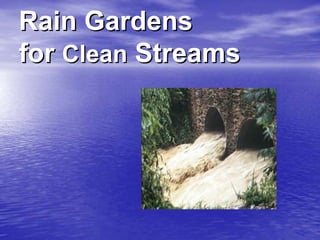
Rain Gardens for Clean Streams
- 1. Rain Gardens for Clean Streams
- 2. Did you know? Up to 70% of pollution in streams, rivers and lakes comes from storm water runoff.
- 3. Planting a Rain Garden… • reduces the amount of storm water entering storm drains • helps reduce the amount of flooding by keeping water contained so that it can drain slowly over a period of time • allows soil to filter out pollutants and reduce the amount of nonpoint source pollution entering our streams
- 4. Nonpoint Source Pollution (NPS) is caused by many reasons.
- 5. Excess fertilizers, herbicides, and insecticides from agricultural lands and residential areas
- 6. Oil, grease, and toxic chemicals from urban runoff and energy production
- 7. Sediment from improperly managed construction sites, crop and forest lands, and eroding stream banks
- 8. Salt from irrigation practices and acid drainage from abandoned mines
- 9. Bacteria and nutrients from livestock, pet wastes, and faulty septic systems
- 10. Rain and snow melt pick up these natural and human-made pollutants, finally depositing them into lakes, rivers, wetlands, coastal waters, and even our underground sources of drinking water
- 11. Impervious surfaces (ones that do not allow water to percolate or drain through soil such as buildings, parking lots, etc) contribute runoff water and increase the amount of pollutants in runoff.
- 12. Rain Garden A garden designed specifically to improve water quality.
- 13. Rain Gardens allow approximately 30% more water to soak into the ground.
- 14. Is a rain garden hard to install ?
- 15. Rain Garden Installation Before
- 16. During
- 17. During
- 18. After planting
- 19. After one season
- 20. Before
- 21. During
- 22. After
- 24. Determine the location Near the house to catch only roof run off or out on the lawn to catch water from the lawn and roof
- 25. Location • A gentle slope (no more than 10%) – Remember that the garden needs to be dug into a bowl shape and the greater the slope the deeper the bowl that will need to be created • At least 10 feet from your foundation • Near a downspout or where water naturally drains • Away from areas where water already ponds as there will be little infiltration in this area
- 26. Planning stage • Estimate the area which will drain into your garden (roof and/or lawn) • Determine the type of soil (sand or clay) • Gardens planted in sandy soil should be 20-30 % the size of the drain area • Gardens planted in clay soil should be 60% of the drain area
- 27. Example Dylan’s house is 50 feet by 40 feet so the roof area is 2000 sq ft. (50 x 40 = 2000) He has two downspouts and will plant a rain garden in the back yard which will collect water from approximately half of the roof area or 1000 sq ft. His soil is sandy so the size of the rain garden should be approximately 250 sq ft. (1000 x .25 = 250)
- 28. Remember that a rain garden of any size will help to control storm water runoff
- 29. Building the Rain Garden • Be sure you check with your utility company before attempting to dig in your yard. • Lay out the garden with a garden hose or landscaper’s spray paint. • Start digging on the uphill side of the garden • Remember that you will be moving soil from the uphill to the downhill side of the garden to create a berm and the bowl shape of the rain garden
- 30. Creating the berm • The berm will be the highest on the downhill side of the rain garden • The berm will gradually decrease as you go up the sides of the rain garden • After shaping the berm be sure to stomp it down so that it is well compacted • Cover the berm with compost/mulch or plant grass or a dry tolerant native plant to control erosion on the berm
- 31. Planting the garden • Consider the height, color, moisture tolerance and bloom time of plant material • Plant in groups of 3, 5 or 7 of the same variety • Add rocks, boulders or other ornamental features to add interest • Water at least once a week until plants are established
- 32. Maintaining the garden • Weed out any invasive or non native plants until natives are established • Stems and seed heads can be left to stand for winter interest and to attract birds and other wildlife to the garden • As spring approaches cut back all standing growth and compost or discard • Occasionally the plants should be divided
- 33. During and after
- 34. Before and after
- 35. Why plant a rain garden ? • To prevent flooding and excess storm water damage • To limit the amount of erosion and cut down on sediment entering our waterways • To filter out and limit the amount of pollutants reaching our waterways • To provide habitat for wildlife
- 36. Rain Gardens for Clean Streams
- 37. Financial and other support for this project is provided by the Pennsylvania Association of Conservation Districts, Inc. through a grant with the U.S. Environmental Protection Agency’s Section 319 Program. The mission of the Bucks County Conservation District is to provide for the wise use, management and development of the county’s soil, water and related natural resources. This is accomplished with the cooperation of public agencies, private groups and individuals
- 38. For more information: Mary Ellen Noonan Environmental Educator Bucks County Conservation District 1456 Ferry Road, Suite 704 Doylestown, PA 18901 215.345.7577 www.bucksccd.org